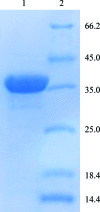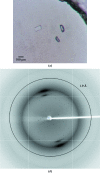Cloning, expression, purification, crystallization and preliminary crystallographic analysis of the kinase domain of AtMAP4Kalpha2 from Arabidopsis thaliana
- PMID: 23832209
- PMCID: PMC3702326
- DOI: 10.1107/S174430911301525X
Cloning, expression, purification, crystallization and preliminary crystallographic analysis of the kinase domain of AtMAP4Kalpha2 from Arabidopsis thaliana
Abstract
Arabidopsis thaliana (At) MAP4Kalpha2, a member of the Ste20/PAK-like protein kinase family, is an essential component of the septum initiation network involved in cell division. To better understand the mode of action of AtMAP4Kalpha2, a structural biology approach has been pursued. In this study, the kinase domain of AtMAP4Kalpha2 was cloned, expressed, purified and crystallized. The crystals diffracted to 1.9 Å resolution and belonged to space group C2221, with unit-cell parameters a = 55.27, b = 82.93, c = 133.15 Å.
Keywords: Arabidopsis thaliana; AtMAP4Kalpha2.
Figures



Similar articles
-
The complex between SOS3 and SOS2 regulatory domain from Arabidopsis thaliana: cloning, expression, purification, crystallization and preliminary X-ray analysis.Acta Crystallogr Sect F Struct Biol Cryst Commun. 2007 Jul 1;63(Pt 7):568-70. doi: 10.1107/S174430910702533X. Epub 2007 Jun 11. Acta Crystallogr Sect F Struct Biol Cryst Commun. 2007. PMID: 17620712 Free PMC article.
-
Cloning, overexpression, purification and preliminary X-ray analysis of the protein kinase domain of enhanced disease resistance 1 (EDR1) from Arabidopsis thaliana.Acta Crystallogr F Struct Biol Commun. 2014 Jul;70(Pt 7):959-62. doi: 10.1107/S2053230X14011844. Epub 2014 Jun 19. Acta Crystallogr F Struct Biol Commun. 2014. PMID: 25005098 Free PMC article.
-
Cloning, purification, crystallization and preliminary X-ray analysis of the receiver domain of the histidine kinase CKI1 from Arabidopsis thaliana.Acta Crystallogr Sect F Struct Biol Cryst Commun. 2009 May 1;65(Pt 5):478-81. doi: 10.1107/S1744309109012032. Epub 2009 Apr 24. Acta Crystallogr Sect F Struct Biol Cryst Commun. 2009. PMID: 19407381 Free PMC article.
-
Crystallization and preliminary crystallographic analysis of Arabidopsis thaliana BRI1-associated kinase 1 (BAK1) cytoplasmic domain.Acta Crystallogr Sect F Struct Biol Cryst Commun. 2012 Mar 1;68(Pt 3):340-2. doi: 10.1107/S1744309112004605. Epub 2012 Feb 22. Acta Crystallogr Sect F Struct Biol Cryst Commun. 2012. PMID: 22442239 Free PMC article.
-
The phosphoinositide-3-OH-kinase-related kinases of Arabidopsis thaliana.EMBO Rep. 2005 Aug;6(8):723-8. doi: 10.1038/sj.embor.7400479. EMBO Rep. 2005. PMID: 16065066 Free PMC article. Review.
References
-
- Bedhomme, M., Jouannic, S., Champion, A., Simanis, V. & Henry, Y. (2008). Plant Physiol. Biochem. 46, 1–10. - PubMed
-
- Champion, A., Jouannic, S., Guillon, S., Mockaitis, K., Krapp, A., Picaud, A., Simanis, V., Kreis, M. & Henry, Y. (2004). J. Cell Sci. 117, 4265–4275. - PubMed
-
- Champion, A., Picaud, A. & Henry, Y. (2004). Trends Plant Sci. 9, 123–129. - PubMed
-
- Corchnoy, S. B., Swartz, T. E., Lewis, J. W., Szundi, I., Briggs, W. R. & Bogomolni, R. A. (2003). J. Biol. Chem. 278, 724–731. - PubMed
-
- Dan, I., Ong, S. E., Watanabe, N. M., Blagoev, B., Nielsen, M. M., Kajikawa, E., Kristiansen, T. Z., Mann, M. & Pandey, A. (2002). J. Biol. Chem. 277, 5929–5939. - PubMed
Publication types
MeSH terms
Substances
LinkOut - more resources
Full Text Sources
Other Literature Sources

